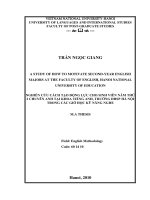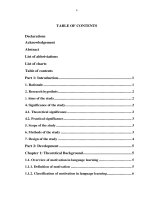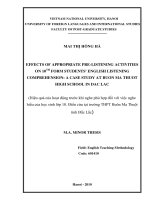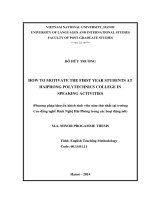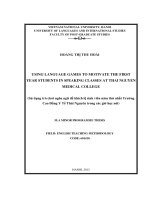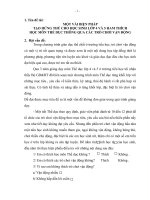How to motivate the 10 grades students in speaking skill A case study at Hoa Lu A high school, Ninh Binh Cách tạo động lực cho học sinh lớp 10 trong giờ học nó
Bạn đang xem bản rút gọn của tài liệu. Xem và tải ngay bản đầy đủ của tài liệu tại đây (563.03 KB, 68 trang )
VIETNAM NATIONAL UNIVERSITY, HANOI
UNIVERSITY OF LANGUAGES AND INTERNATIONAL STUDIES
FACULTY OF POST - GRADUATE STUDIES
*********
MAI THỊ LAN
HOW TO MOTIVATE THE 10 GRADE STUDENTS
IN SPEAKING SKILL:
AT HOA LU A HIGH SCHOOL, NINH BÌNH
CÁCH TẠO ĐỘNG LỰC CHO HỌC SINH LỚP 10 TRONG GIỜ
HỌC NÓI TẠI TRƯỜNG THPT HOA LƯ A, NINH BÌNH.
M.A. MINOR PROGRAMME THESIS
Field: English Teaching Methodology
Code: 60 14 10
Hanoi – 2013
VIETNAM NATIONAL UNIVERSITY, HANOI
UNIVERSITY OF LANGUAGES AND INTERNATIONAL STUDIES
FACULTY OF POST - GRADUATE STUDIES
*********
MAI THỊ LAN
HOW TO MOTIVATE THE 10 GRADE STUDENTS
IN SPEAKING SKILL:
AT HOA LU A HIGH SCHOOL, NINH BÌNH
CÁCH TẠO ĐỘNG LỰC CHO HỌC SINH LỚP 10 TRONG GIỜ
HỌC NÓI TẠI TRƯỜNG THPT HOA LƯ A, NINH BÌNH.
M.A. MINOR PROGRAMME THESIS
Field: English Teaching Methodology
Code: 60 14 10
Supervisor: Phan Thị Vân Quyên, M.A
Hanoi – 2013
iv
LIST OF ABBREVIATIONS
L2: Second language
EFL:English as a Foreign Language
TEFL: Teaching English as a Foreign Language
M.A: Master of Arts
CLT: Communication Language Teaching
S: Student
v
LIST OF TABLES
Table 1: Students’attitude towards speaking skills
Table 2: Types of motivation
Table 3.1 and Table 3.2: Factors affecting motivation in learning speaking English
Table 4.1 and Table 4.2: Current methods and techniques applied to teach speaking
skill
Table 5: Students’interest and desires for speaking activities
Table 6: Teachers’opinion on students’motivation in speaking English
Table 7.1 and Table 7.2: Teacher’attitude towards unwilling speakers and mistake
makers
Table 8: Teachers’difficulties in teaching speaking at Hoa Lu A high school
Table 9.1 and 9.2: Activities and techniques used by teachers to motivate students to
speak
vi
TABLE OF CONTENT
Declaration i
Acknowledgements……………………………………………………………….ii
Abstract……………………………………………………………… …………iii
List of abbreviations…………………………………………………… ………iv
List of tables……………………………………………………………… …… v
Table of content…………………………………………………….……………vi
PART A: INTRODUCTION……………………………………… ………… 1
1. Rationale…………………………………………………………… ….1
2. Aims of the study………………………………………………….… …2
3. Research questions……………………………………………………….2
4. Methods of the study……………………………………………… … 2
5. Scope of the study……………………………………………………… 2
6. Design of the study………………………………………………………3
PART B: DEVELOPMENT…………………………………………… …… 4
CHAPTER I: Theoretical Background……………………… ……………….4
I. Motivation in second language learning………………………………………4
I.1. Definition of motivation……………………………………………… 4
I.2. Types of motivation…………………………………………………….5
I.2.1. Intergrative and Instrumental motivation…………………… 5
I.2.2. Intrinsic and Extrinsic motivation…………………………….6
I.2.3. Global motivation………………………………….………….8
I.2.4. Situational motivation……………………………………… 8
I.2.5. Task motivation…………………………………………….…8
I.2.6. Resultate motivation……………………………………….….8
I.3. Factors affecting learners’motivation in language learning………… 8
I.3.1. Learners’factors…………………………………………… 9
vii
I.3.1.a. Intelligence……………………………………… …9
I.3.1.b. Aptitude………………………………………… …9
I.3.1.c. Personality……………………………… ………….9
I.3.1.d. Learning strategies……………………… …………9
I.3.1.e. Learners’belief…………………………….……… 10
I.3.1.f. Age of acquisition………………………….……….10
I.3.2. Teachers’factors……………………………………….…….10
I.3.2. a. Enthusiasm……………………………………… 10
I.3.2. b. Commitment to the students’progress…………… 11
I.3.2. c. Teachers’expectations…………………………… 11
I.3.2. d. Good relationship with the students……………….11
I.3.3. Teaching and learning conditions……………………………12
I.3.3. a. Physical conditions………………………… ……12
I.3.3. b. A pleasant and supportive atmosphere in the class 12
II. Speaking in second language learning…………………… ………………13
II.1. Definition of speaking……………………………………………… 13
II.2. Importance of speaking in language teaching and learning………….13
II.3. Approaches to the teaching and speaking……………………………14
II.3.a. The grammar – translation Method…………………………14
II.3. b. The Direct Method and Audio – lingual Method………… 14
II.3. c. Communicative Language Teaching……………………….15
III. Types of stimulating activities in teaching speaking skill……………… 15
III.1. Discussions………………………………………………………….15
III. 2. Role play……………………………………………………………15
III. 3. Simulations…………………………………………………………16
III. 4. Games………………………………………………………………16
III. 5. Drama………………………………………………………………17
viii
III. 6. Storytelling…………………………………………………………19
III. 7. Group work…………………………………………………………19
IV. Previous studies…………………………………………………………… 20
CHAPTER II: Methodology……………………………………………………22
I. Overview of the research site…………………………………….………… 22
I.1. Hoa Lu A high school…………………………………….………… 22
I.2. The teachers………………………………………………….……….22
I.3. Textbook…………………………………………………….……… 23
I. 4. Teaching and learning English in 10
th
Form…………… ………… 23
II. Methodology…………………………………………………….……………23
II. 1. The participants…………………………………………………… 24
II. 1. 1. The students………………………………………….……24
II. 1. 2. The teachers…………………………………………….…24
II. 2. The data collection instruments………………………………… …24
II. 2. 1. The questionnaire…………………………………………24
II. 2. 2. Informal interview……………………………………… 25
II.3. Data collection procedure and data analysis ……………………… 25
II.3. 1. Data collection procedure……………………………… 25
II.3. 2. Data analysis………………………………………………26
III. Concluding remark…………………………………………………………26
CHAPTER III: Major findings and discussion……………………………….27
I. Questionnaires for students………………………….………………………27
I.1. Students’attitude towards speaking skill…………………….……… 27
I. 2. Students’motivation in learning speaking English………………… 28
I. 3. Factors affecting students’motivation in learning speaking English…30
I. 4. Current methods and techniques applied to teach speaking skill…….32
I. 5. Students’interest and desires for speaking activities…………………34
ix
II. Questionnaires for teachers…………………………………………………37
II. 1. Teachers’opinion on students’motivation in speaking English…… 37
II. 2. Teachers’attitude towards unwilling speakers and mistake makers 38
II. 3. Difficulties teachers have encountered in teaching speaking at
Hoa Lu A high school……………………………………………… ……39
II. 4. Activities and techniques used by the teachers to motivate
students to speak………………………………………………… ………40
CHAPTER IV: Recommemdations for the teachers…………………………44
1. Identify students’types of motivation…………………….…………….44
2. Help students to be confident………………………………………… 44
3. Help students to enrich students’vocabulary and improve their knowledge of
grammar……………………………………………… 45
4. Help students to overcome pronunciation problems…… …….………46
5. Help students to find ideas………………………………….………… 47
PART C: CONCLUSION…………………………… ………………………48
I. Conclusion……………………………………… …………………… 48
II. Limitation of the study and suggestion for further study………………49
REFERENCES:…………………………………… ………………………….50
APPENDICES……………………………………………………………………I
APPENDIX 1: QUESTIONNAIRE FOR STUDENTS………………………… I
APPENDIX 2: QUESTIONNAIRE FOR TEACHERS………………………….v
APPENDIX 3: INFORMAL INTERVIEW FOR STUDENTS…………… VIII
1
PART A: INTRODUCTION
1. Rationale
After the historic upheaval, Vietnam’economy, politics and culture have been
undergone extensive changes. Thanks to the open - door policy, Vietnam has
diplomatic relationship with all over the world. English becomes an indispensable
means of communication with the rest of the world and it is the most important
international language because it provides ready acces to the world scholarship and
world trade. Since then English has become a compulsory subject in Vietnam
curriculum, its teaching and learning have been paid much attention.
In learning English at high schools, English speaking skill is one of the four
skills that students must be taught as separately and equally as the others. However,
due to some differently objective and subjective reasons, teaching and learning this
skill is often integrated with other skills such as listening skill, or is even neglected. It
leads to the cause that students do not often enjoy speaking period as well as find it
difficult to participate in speaking activities.
Besides, at Hoa Lu A high school, like at many other high schools in Vietnam.
English has been a compulsory subject in secondary curriculum for many years. The
fact is that, due to the demand of high school and university entrance examinations, the
students’focus is on grammar and vocabulary, which means little attention has been
paid to speaking skill.
With 6 years of experience in teaching English at high school, I have realized
that there are many factors affecting the success of language learners such as aptitude,
age, personality, motivation and so on, among which motivation plays an important
role. For teaching and learning speaking skill, the impact of motivation is not an
exception. It is undeniable that if the students are motivated, especially from the warm
- up stage, their speaking will be completed more successful and their difficulties in
speaking will no longer exist.
2
All the above mentioned reasons have inspired the writer to conduct a research
title “How to motivate the 10 grade students in the speaking skill at Hoa Lu A high
school”.
2. Aims of the study
The aims of the study are:
- To investigate the current situation of teaching and learning speaking skill in
grade 10 at Hoa Lu A high school.
- To identify types of the motivation and factors affecting students’ motivation
in learning speaking skill.
- To suggest speaking teaching techniques used to motivate students to take part
in speaking activities.
3. Research questions.
The study intends to find out the answers to the following questions:
1. What are the types of motivation possessed by Grade 10 students in learning
speaking English?
2. What have teachers done to motivate students in learning speaking English?
3. What are students’expectation of speaking teaching?
4. Methods of the study.
To conduct the study, I am going to use quantitative and qualitative methods.
The data collected for the study will come from two sources: the 10
th
grade student
respondents and the English teacher respondents at Hoa Lu A high school, Ninh Binh.
Two questionnaires, one for students and the other for teachers, and informal
interwiews of students are going to be used as data collection instruments. All the
comments, recommendations and conclusions provided in the study will be based on
the data analysis.
5. Scope of the study
3
Studying motivation and its effects on the second language have been paid
attention by many researchers so far. However, due to the limit of time and capacity,
within the scope of an M.A. minor thesis, the researcher only focuses on the types of
motivation possessed by Grade 10 students in learning speaking English; some
activities used by the teachers to motivate them to speak English; and students’
expectation to activities and techniques applied by teachers in speaking teaching; then
suggests some recommendations for teachers to motivate students to speak more.
6. Design of the study.
The study is divided into three parts: the Introduction, the Development and the
Conclusion.
Part A: Introduction - deals with the rationale, aims, research questions,
methods, scope, design of the study.
Part B: Development - consists of four chapters
Chapter I - Theoretical Background - is intended to give some theoretical
background related to motivation and speaking.
Chapter II - Methodology - presents the Research site, Methodology (including
the participants, instruments, data collection and analysis procedure).
Chapter III - Major findings, discussions - shows major findings and
discussions.
Chapter IV – Recommendations - offers some recommendations for teachers
to motivate students to speak more in speaking lesson.
Part C: Conclusion - conclusion, limitations of the study, suggestions for
further research.
4
PART B: DEVELOPMENT
CHARTER I: Theoretical Background
As a way of start, I will first provide the theoretical background about
Motivation consisting of its definition, types and factors affecting learners’motivation.
Then I will provide the theoretical background about Speaking including its definition,
importance in language teaching and learning, and approaches to the teaching of
speaking. The end of this chapter is to reexamine different types of stimulating
activities that the English teacher often uses to teach a speaking class.
I. Motivation in second language learning
I.1. Definition of motivation
In almost all fields of learning and teaching, especially language education,
motivation has always been considered an essential factor contributing to success. In
L2 achievement, motivation is an important affectivity. It means that motivation of
high levels often leads to high L2 achievement and proficiency. The motivated learners
are usually more active in learning, while unmotivated learners are more likely to cause
classroom disturbances. Therefore, a thorough understanding of this concept is needed.
According to Williams and Burden (1997:20), motivation is a “state of cognitive
arouse” which provokes a “decision to act”; as a result of which, there is “sustained
intellectual and/or physical effort” so that a person can achieve some “previously set
goal”.
Another linguist, Woolfolk (2001:366) defines motivation as “an internal state
that arouses, directs, and maintains behavior”
Additionally, Dornyei, (2001: 17) claims that “ motivation explains why people
decide to do something, how hard they are going to pursue it and how long they are
going to sustain their activities.” Similarly, Brown (2000:160) indicated that
“motivation is some kind of internal drive which pushes someone to do things in order
to achieve something”.
5
It can be seen that different researchers approach motivation definition in
different ways. However, this research will follow the definition of motivation
proposed by Gardner (1982:132-147) that motivation perceived to be composed of
three elements. These include effort, desire and affect. Effort refers to the time spent
studying the language and the drive of the learner. Desire indicates how much the
learner wants to become proficient in the language, and affect illustrates the learner’s
emotional reactions with regard to language study. He also remarks “motivation
involves four aspects: a goal, effortful behavior, a desire to attain the goal, and
favorable attitudes towards the activity in question”. He sees the important role of
effort and desire to achieve the learning goal “Motivation in the present context refers
to the combination of effort plus desire to achieve the goal of learning plus favourable
attitudes towards learning the language”(1985:10).
I.2. Types of motivation
I.2.1. Integrative and instrumental motivation
Gardner and Lambert (1972: 10) distinguished integrative and instrumental as
two types of motivation.
Integrative motivation: Motivation has been identified as the learner's
orientation with regard to the goal of learning a second language (Crookes and Schmidt
1991). It is thought that students who are most successful when learning a target
language are those who like the people that speak the language, admire the culture and
have a desire to become familiar with or even integrate into the society in which the
language is used (Falk 1978). This form of motivation is known as integrative
motivation. When someone becomes a resident in a new community that uses the target
language in its social interactions, integrative motivation is a key component in
assisting the learner to develop some level of proficiency in the language. It becomes a
necessity, in order to operate socially in the community and become one of its
members. It is also theorised that "integrative motivation typically underlies successful
6
acquisition of a wide range of registers and a nativelike pronunciation" (Finegan
1999:568).
Instrumental motivation: In contrast to integrative motivation is the form of
motivation referred to as instrumental motivation. It is something which concerns “the
practical value and advantages of learning a new language ” (Lambert 1974: 98 - cited
in Ellis, 1997) and which is characterized by “the wish to learn the language for
purposes of study or career promotion” (Ur, 1996: 276) and the desire to obtain
something practical or concrete from the study of a second language (Hudson 2000).
With instrumental motivation the purpose of language acquisition is more utilitarian,
such as meeting the requirements for school or university graduation, applying for a
job, requesting higher pay based on language ability, reading technical material,
translation work or achieving higher social status. Instrumental motivation is often
characteristic of second language acquisition, where little or no social integration of the
learner into a community using the target language takes place, or in some instances is
even desired.
I.2.2. Intrinsic and Extrinsic motivation
Intrinsic motivation: Intrinsic motivation refers to “motivation to engage in an
activity for its own sake” (Woldkowski, 1999). He means that the activity itself is our
own benefit, so we do not need any other kinds of rewards or punishment. He also
states that intrinsic motivation “is the natural tendency to seek out and conquer
challenges as we pursue personal interests and exercise capabilities”. The factors of
support of intrinsic motivation include: competence (the feeling that you know how to
do things), autonomy (being able to perform an activity by yourself without external
help), and relatedness (connection with your social environment like helping others).
Although intrinsic motivation has typically been seen as a unidimensional construct,
Vallerand and his colleagues (as quoted in Dornyei 2001) have recently posited the
existence of three subtypes of intrinsic motivation:
7
+ To learn: engaging in an activity for the pleasure and satisfaction of
understanding something new, satisfying one’s curiosity, and exploring the world.
+ Towards achievement: engaging in an activity for the satisfaction of
surpassing oneself, coping with challenges, and accomplishing or creating something.
+ To experience stimulation: engaging in an activity to experience pleasant
sensations.
Extrinsic motivation: Harmer (2001: 51) remarks that extrinsic motivation “is
caused by any number of outside factors such as the need to pass an exam, the hope of
financial reward or the possibility of future travel”. In addition, Dornyei (2001) states
that according to self-determination theory, a variety of regulations exist and can be
placed on a continuum between self-determined (intrinsic) and controlled (extrinsic)
forms of motivation, depending on how much the regulation has been transferred from
outside to inside the individual. Four types of extrinsic motivation are elaborated:
+ External regulation refers to the least self-determined form of extrinsic
motivation, coming entirely from external sources such as rewards or threats (e.g. the
teacher’s praise or parental confrontation).
+ Introjected regulation involves externally imposed rules that the students
accept as norms to be followed in order not to feel guilty (e.g. rules against playing
truant from class).
+ Identified regulation occurs when the person engages in an activity because
he/ she highly values and identifies with the behavior, and sees its usefulness (e.g.
learning a language which is necessary to pursue one’s hobbies or interests).
+ Integrated regulation is the most developmentally advanced form of extrinsic
motivation, involving choiceful behavior that is fully assimilated with the individual’s
other values, needs, and identity (e.g. learning English because its proficiency is an
educated cosmopolitan culture one has adopted).
8
Most scholars agree that intrinsic and extrinsic motivations interact with each
other and both play an important role in language learning and teaching. As a result,
learners can be either motivated by internal or external factors depending on the
circumstances and conditions under which the learning activity is being performed.
I.2.3. Global motivation: Brown (1994) definies global motivation as a general
orientation to the goal of an L2 learning which may be affected by such factors as
previous education, social factors as well as the teachers’attitudes.
I.2.4. Situational motivation: refers to the learning context: classroom, total
environment assumed to be influenced by teacher action. Brown (1994) distinguishes
the difference in situational motivation according to the situation in which learning
takes place. Thus the motivation in the classroom setting differs from that in natural
setting.
I.2.5. Task motivation: This motivation occurs when learners are performing some
particular tasks in learning performance. An attractive task designed by the teacher in
class may encourage learners to invest their effort and energy in.
I.2.6. Resultative motivation: In some cases, motivation is the result of learning.
Hermann (1980) stated that “it is success that contributes to motivation rather than vice
- versa”(cited in Ellis, 1997). Ellis (1997) also concluded that “the relationship between
motivation and achievement is an interaction one. A high level of motivation does
stimulate learning, but perceived success in achieving L2 goals can help to maintain
existing motivation and even create new types.
I.3 Factors affecting learners’motivation in language learning.
There are a variety of factors influencing learners’motivation such as learners
themselves, parents, community, the learning context, the teacher, the subject matters,
etc. However, the author of this research pays much of the attention to some most
common and influential factors namely, learners’factors, teachers’factors, teaching and
learning condition.
9
I.3.1. Learners’factors
I.3.1.a. Intelligence: Intelligence is the term referring to performance on certain kinds
of tests ( Lightbown & Spada, 1999:52). Through these tests, teachers are able to
classify successful or unsuccessful students in the class performance. While some
studies have reported that there is a link between intelligence measured by IQ tests and
L2 learning, some students, in fact, whose academic performance is weak, are
successful in L2 learning.
I.3.1.b. Aptitude:According to Lightbown and Spada (1999:53) aptitude consists of:
(1) the ability to identify and memorize new sounds.
(2) the ability to understand the function of particular words in sentences.
(3) the ability to figure out grammatical rules from language samples.
(4) the ability to memorize new words.
I.3.1.c. Personality: In the eyes of many language teachers, the personality of the
student constitutes a major factor contributing to success or failure in laguage learning.
Ellis (1997) has proved that extroverted learner are advantaged in the development of
the kind of language associated with basis interpersonal communication skills and that
extroverted learners may also be more likely to participate actively in oral
communication (1997:523). Shared the same view with Ellis, Lightbown and Spada list
a number of personality characteristics that have a great influence on the success of
second language learners: extroversion, inhibition, self-esteem, empathy, dominance,
talkativeness and responsiveness (1999:54-55).
I 3.1.d. Learning strategies: Learners’learning strategies can affect their mood to make
them participate actively or passively in learning activities. One definition of learning
strategies is: “Steps or actions taken by learners to improve the development of their
language skills” (Gass et al 1993: 265). Learning strategies are really helpful to
students as they assist them to improve their learning proficiency and efficiency as well
10
as their academic achievements. Moreover, appropriate strategies do help students
process the lesson actively and connect what they are learning with what they have
already known. However, learners must be flexible in employing learning strategies;
otherwise, their learning expectations cannot fulfilled. In addition, it is true that more
highly motivated learners use a greater range of proper strategies than less motivated
learners. It is advisable that the teachers teach the learners appropriate strategies and
assist them in practicing using these in their learning.
I.3.1.e. Leaners’ belief: Most learners have strong belief about how languages are
learnt, how their instruction should be delivered. “These beliefs are usually based on
previous learning experiences and the assumption (right or wrong) that a particular
type of instruction is the best way for them to learn”. ( Lightbrown, 1999:59)
I.3.1.f. Age of acquisition: Age is another characteristic of learners which affects
learners’success in L2 learning. It is believed that children are better than adults in
acquiring a L2 in general and in speaking a new language with native - like fluency in
particular. Some researchers conclude that younger learners have great chance of
attaining native - like proficiency in the L2, older learners may show faster progress at
the beginning, but are probably surpassed by the young ones in the end.
I.3.2. Teachers’factors
Based on Dornyei (2001), teachers' factors and appropriate behaviors are
mentioned as follows:
I.3.2.a. Enthusiasm: An American psychologist, Mihaly Csikszentmihalyi (1997) said
that teachers needed to be “enthused and involved in the teaching process and in the
material they are teaching” (cited in Dornyei, 2001:178). He also points out that
enthusiastic teachers are the ones who love what they are doing, who show by their
dedication and passion that make learners willing to pursue knowledge” (cited in
Dornyei, 2001; 177- 178).
11
Also, teachers should clearly identify their reasons for loving and being
interested in the subject matter or L2, and then share these reasons with their students
(Good & Brophy, 1994).
I.3.2.b. Commitment to the students'progress: Teachers should show commitment
towards their students'learning and progress, at the same time they should care for what
their students have learnt and succeeded (Dornyei, 2001).
In order to express commitment towards the students, teachers should:
+ offer concrete assistance
+ offer to meet students individually to explain things
+ respond immediately when help is requested
+ correct tests and papers promptly
+ send learners copies of relevant interesting articles
+ arrange extra-curricular instructional programs
+ encourage extra- assignments and offer to assist with these
+ Show concern when things are not going on
+ allow students to call at home when they have a problem
+ be available for overtime
Furthermore, if teachers treat their students "as if they already are eager
learners, they are likely to become eager learners" (Brophy, 1998: 170).
I.3.2.c.Teachers' expectations: Students tend to perform at a level which is consistent
with the teacher's expectations. Particularly, when the teacher sets high expectations,
they are likely to perform better at the subject matter and even feel more competent
(Good & Brophy, 1994).
I.3.2.d. Good relationship with the students
- Acceptance: three linchpins of the humanistic psychology; namely;
acceptance, empathy and congruence, are of great influence in the development of
student-centered teaching.
12
- Ability to listen and pay attention to students: listening to a person is the single
most powerful transaction that occurs between ourselves and another person
(Woldkowski, 2008: 28).
Following are several gestures which can convey personal attention by Burden (1995):
+ Greet students and remember their names
+ Smile at them
+ Notice interesting features of their appearance
+ Ask them about their lives outside school
+ Show interest in their hobbies
+ Move around in class
+ Send notes to absent students
I.3.3. Teaching and learning conditions
I.3.3.a. Physical conditions: Physical conditions in the classroom refer to the classroom
size, chairs, desks, tables, boards and even bulletin boards. Jeremy Harmer (1991)
confirmed that such physical condition had great impact on students' learning as well
as their attitude towards the subject matter. These affect students' motivation either
positively or negatively.
L2 teachers should be reminded that the classroom is not only a psychological
but also physical environment. The decoration: posters, flowers, funny objects
influence strongly the atmosphere. More importantly, teachers should create the
ownership of the class among students as "Personalizing the classroom can be seen as
students exercising increasing control over their environment" (Dornyei, 2001: 42).
I.3.3.b. A pleasant and supportive atmosphere in the classroom
A pleasant and supportive atmosphere will create motivation. It encourages
students to express their opinions and thinking. Thus, it is the teacher's task to create a
pleasant and supportive classroom atmosphere.
13
A number of various components contribute to make up the ideal classroom
climate such as the teacher's rapport with the students, the students' relationship with
each other and the norm of tolerance; which helps students feel safe and comfortable
taking risks. It is very important to make students that mistakes are a natural part of
learning, and to ensure that they will not be criticized if they make mistakes.
Moreover, humor is a very potent factor to improve the classroom atmosphere.
The use of humor helps students feel at ease without tension in the air. Scheidecker and
Freeman (1999: 138) had a summary on the essence of the ideal classroom climate:
"When one watches students enter such a classroom, one classroom, one gets an
overwhelming sense that the students shed emotional baggage at the doorway. This is
an emotional safe zone."
II. Speaking in second language learning.
II.1. Definition of speaking.
There are many definitions of speaking. In his own view, Mackey (1965) shows
that “ oral expression involves not only the use of the right sounds in the right patterns
of rhythm and intonation, but also a choice of words and inflections in the right order
to convey the right meaning”, (cited in Bygate, 1997:5). According to Mackey, for the
student who wants to be good at speaking, he/she has to choose the right forms, put
them in correct order, sound it like native speaker and even produce the right
meanings. In addition, Bailey (2005:2) definies “ speaking is the productive, oral skill.
It consists of producing systematic verbal utterances to convey meaning.” Chaney
(1998:13) shares the same view that speaking is “the process of building and sharing
meaning through the use of verbal and non verbal symbols, in a variety contexts”.
II.2. Importance of speaking in language teaching and learning.
Speaking plays an utmost important role among the four language skills since it
helps to identify who knows or does not know a language. Pattison (1992) confirms
that when people know or learn a language, they mean being able to speak the
14
language. More than this, Ur, P (1996) shows that people who knows a language are
referred to as “speaker” of that language as if speaking included all other kinds of
knowing.
Moreover, oral English can be very useful for development of reading and
writing skills. Rivers points out: “ when we read and write, we call upon what we know
of the language orally”. (Rivers, 1968: 20) He goes on to say that there must be a
connection between reading and speaking. If the students are reading, and then they are
using their oral English, too. If a student has poor English, his reading ability may also
be poor. Similarly, Rivers (1968) argues that writing involves oral ability as well.
II.3. Approaches to the teaching of speaking.
II.3.a. The Grammar - translation Method
In the Grammar - translation Method, students are taught to analyze grammar
and to translate from one language to another. The Grammar translation method,
therefore, does not really prepare students to speak English, and it is not entirely
appropriate for students to improve their speaking skill. In conclusion, the Grammar -
translation Method is not consistent with the goals of increasing English learners’
fluency, oral production or communicative competence.
II.3.b. The Direct Method and Audio - lingual Method:
The Direct Method focused on “everyday vocabulary and sentences” (Richards
and Rodgers, 1986:9) and lessons were conducted entirely in the target language. This
Method emphasized in that “new teaching points were introduced orally rather in
writing. Also, lessons emphasized speaking and listening, which were practiced in a
carefully graded progression organized around question and answer exchanges between
teachers and students.” (Richards and Rodgers, 1986:10 as cited in Bailey, 2005:17).
In Audio - lingual Method, speaking is taught by having students repeat
sentences and recite memorized dialogues from the textbook. In this method, the lesson
emphasized repetition drills in order to familiarize students with the sounds and
15
structural patterns of the language. In short, memorizing patterns did not lead to fluent
and effective communication in real - life situations. (cited in Bailey, 2005:17)
II.3.c. Communicative Language Teaching: At the end of the 1960s, the Audio -
Lingual Method met a drastic attack from both American sociolinguistics and British
functional linguistics based on the study of language from a wider prospective. The
Grammar translation method and the Direct method and Audio - lingual Method did
not lead to fluent and effective communication in real - life situation, the
Communication language teaching (CLT) evoked. The goal of language teaching in the
light of CLT is to develop communication competence. In CLT classroom, learners are
encouraged to contribute as much as they gain, and learn in an independent way. In
CLT favors interaction among small numbers of learners with purpose to maximine the
time each learner learns and uses languages, shares information and negotiates
meaning.
III. Types of stimulating activities in teaching speaking skill.
III.1. Discussions
After a content-based lesson, a discussion can be held for various reasons. The
students may aim to arrive at a conclusion, share ideas about an event, or find solutions
in their discussion groups. Before the discussion, it is essential that the purpose of the
discussion activity is set by the teacher. In this way, the discussion points are relevant
to this purpose, so that students do not spend their time chatting with each other about
irrelevant things.
III.2. Role Play
There are many interesting and motivating methods available to English
teachers, and “Role-play authentic situation is one avenue leading to improved
communicative ability in the target language” (Maxwell, 1997, p.6). Thus, role-play
could be one of the most useful teaching methods used to enhance
students’learning attitudes/motivation, increase their speaking ability and overcome
16
their shyness. As Maxwell (1997) pointed out the problems of those English teaching
methods, and argued that there is a need to develop more
diverse English teaching
methods or activities. Role -play is one of the main teaching
methods to help
students improve their L2 learning in three aspects. First, role -play might help develop
students’speaking ability. Second, role-play might meliorate students’ attitudes/
motivation toward learning L2. Third, role -play might help students overcome their
shyness. The purpose of role-play is “to improve students’ verbal and nonverbal
communication skills and to link and use previously built schemas, in both
structured and improvised situations ” (Maxwell, 1997, p.1). Teachers use role -play
as one of the teaching methods to force students to speak in public.The common
weakness of Vietnamese students is their speaking ability. They seldom have the
chance to practice conversation, even in the second language classroom.
III.3. Simulations
Simulations are very similar to role-plays but what makes simulations different
than role plays is that they are more elaborate. The most common view of simulations
is that they provide a way of creating a rich communicative environment (a
representation of reality) where students actively become a part of some real-world
system and function according to predetermined roles as members of that group. More
important, however, is the notion that a simulation becomes reality and the "feeling of
representivity fades" (Crookall & Oxford, 1990, p. 15).
III.4. Games
Games are one of the useful activities to motivate students in speaking.
According to Carrier (1980:6) “Games stimulate students’participation and give them
confidence”. Hadfield (1987) also classifies language games into many more categories
as follows: Sorting, ordering or arranging games; Information gap game; Guessing
games; Matching games; Labeling games; Puzzle-solving games.
17
Using language games, which have long been advocated for assisting language
learning, in speaking classes seems to be a good choice for the following reasons:
* Games add interest to what students might not find very interesting. Language
learning is hard work. Effort is required at every moment and must be maintained over
a long period of time. Games help and encourage many students to sustain their interest
and work. Sustaining interest can mean sustaining effort. After all, learning language
involves long term effort.
* The variety and intensity that games offer may lower anxiety and encourage
shyer students to take part in speaking classes positively, especially when games are
played in small groups.
* Games also help the teachers to create contexts in which the language is
meaningful and useful. The students want to take part in and in order to do so they
must understand what others are saying and they must speak in order to express their
own point of view or give information.
* Games are student-centered in that students are active in playing the games
and games can often be organized such that students have the leading roles, with
teachers as facilitators.
III.5. Drama.
Using drama and drama activities have clear advantages for language learning.
Drama encourages students to speak, it gives them the chance to communicate, even
with limited language, using non-verbal communication, such as body movements and
facial expression. There are also a number of other factors which makes drama a very
powerful tool in the language classroom. Desiatova (2009) outlined some of the areas
where drama is very useful to language learners and teachers, and they are listed
below:
* To give learners an experience (dry-run) of using the language for genuine
communication and real life purposes; and by generating a need to speak. Drama is an


